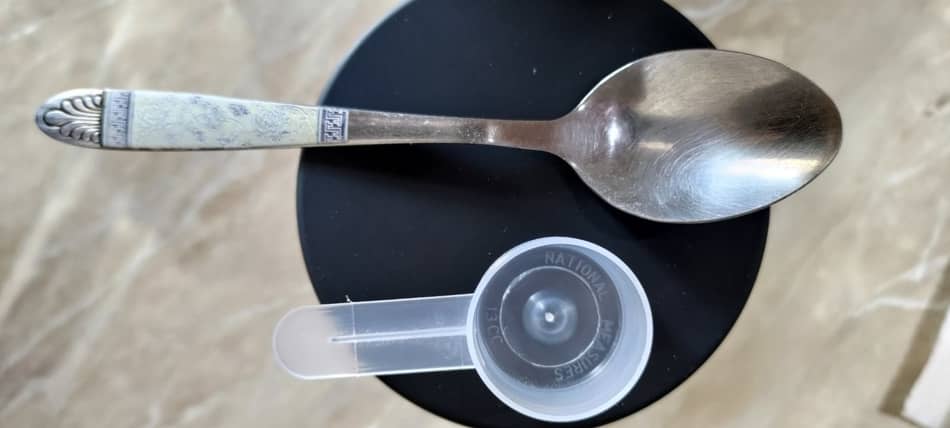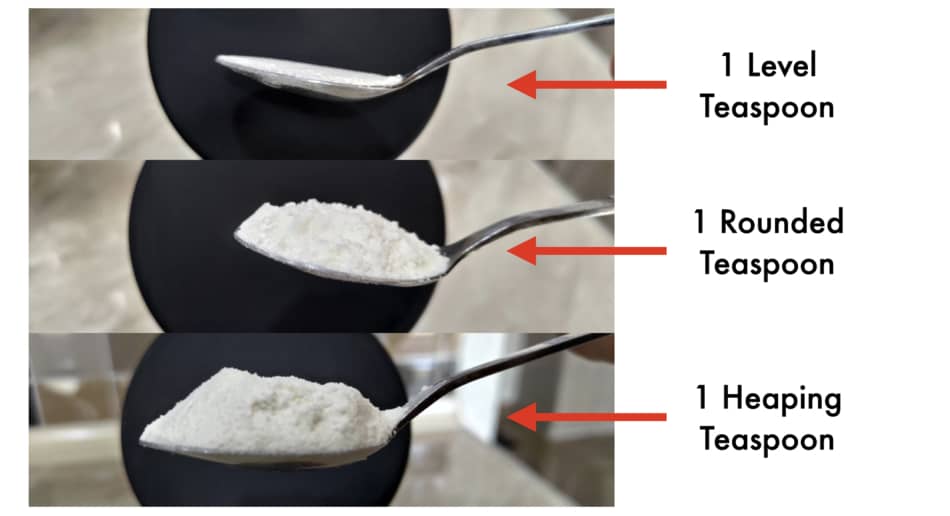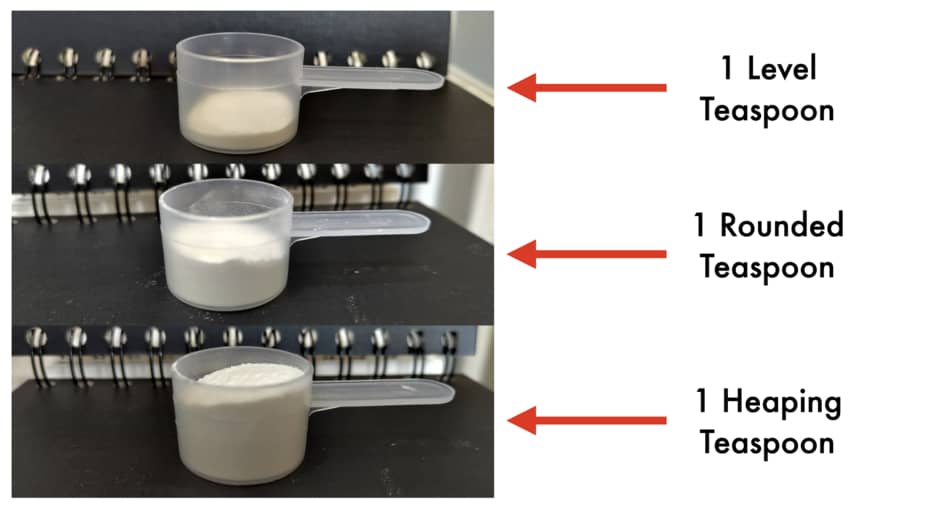No, Optimum Nutrition Micronized Creatine does not include a serving scoop. The supplement label recommends using one rounded teaspoon to measure the 5-gram serving size. However, using a teaspoon is less precise than a dedicated 5-gram scoop. For accurate measurement, use a kitchen scale or a level teaspoon, which holds approximately 5 grams. Keep in mind that the density of creatine can vary, so a teaspoon may not always equal exactly 5 grams. Measuring creatine without a scoop precisely ensures you consume the recommended dose for optimal results.

Does Optimum Nutrition Creatine Come With A Scoop?
No, Optimum Nutrition confirmed that their creatine does not come with a scoop, and a “rounded teaspoon” serves as the measurement for one serving of their micronized creatine monohydrate powder.
I’ve bought many ON supplements in the past, such as pre-workouts, protein powders, amino acids, and glutamine. I’ve rarely had a problem or issues where my creatine didn’t come with a scoop. Perhaps one out of a hundred creatines had no scoop, but I believe that was the manufacturer’s fault.
However, my experience with ON creatine was different. When I received my Optimum Nutrition creatine without a scoop, I contacted ON’s customer service. They confirmed that a serving size of micronized creatine monohydrate powder is measured as a ’rounded teaspoon’. Also, the product label instructs using a teaspoon, not a scoop, for measurement, which I find odd.
Why There Is No Scoop In Optimum Nutrition Creatine?
Optimum Nutrition’s Creatine often does not include a scoop to reduce packaging waste and simplify production. This decision aligns with their stated vision to reduce their environmental impact by minimizing waste in their operations.
At least that’s what I thought.
Optimum Nutrition micronized creatine monohydrate powder is manufactured by Glanbia Performance Nutrition, a leading global manufacturer of sports and lifestyle supplements. On their website, you can read that their vision is to reduce carbon in their daily operations, as well as use less water and produce less waste. Initially, I thought that the lack of a plastic scoop in their creatine was related to the company’s ‘climate change’ vision. Perhaps removing the scoop is a way for them to be more environmentally friendly. However, that is not the case. All their other products, such as Amino Energy, Gold Standard pre-workout, and protein powders, include a scoop for measuring. Only creatine monohydrate suggests using a rounded teaspoon.
Secondly, I thought this might be related to the form of creatine. ON’s creatine monohydrate is micronized, meaning its particles are smaller. This makes it easier to mix with water and potentially easier for the body to absorb.
That’s not the case either.
Micronized creatine monohydrate is quickly becoming the industry standard. Many brands, such as Nutricost Performance and 1st Phorm, already use this form of creatine and have moved away from using a “rounded teaspoon” as a measurement. They use scoops.
Is Using Rounded Teaspoon to Measure Creatine a Good Idea?
No, using a rounded teaspoon to measure creatine is not a precise method. A teaspoon can vary in volume and may lead to underdosing or overdosing. For accuracy, use a digital scale to measure the recommended serving size, typically 3-5 grams, depending on the supplement instructions.
Creatine supplement companies express serving sizes in various ways, such as tablets, capsules, scoops, soft gels, packets, tablespoons, and teaspoons. However, I don’t believe using teaspoons to measure creatine powder is a good idea for a couple of reasons. Firstly, a rounded teaspoon is very subjective, and people can interpret it differently.
To illustrate my point, my wife and I compared a standard 5ml teaspoon and a standard 13cc creatine scoop with a plastic scoop that came with one of my pre-workouts. The following picture shows a metal spoon and a clear plastic measuring 13 cc scoop size lying on a black creatine container.

For the record, a 13 cc scoop is equivalent to 13 grams. The plastic scoop has a line that indicates 10 grams (which is the recommended dose for the supplement where I took it from).
In this experiment, we decided to use three different ways to measure teaspoons.
- Level Teaspoon: A level teaspoon holds powder that is evenly flattened and does not exceed the spoon’s edges.
- Rounded Teaspoon: A rounded teaspoon means filling a teaspoon with creatine so it has a small hill of powder above the spoon’s edges. This measurement is slightly more than a leveled teaspoon and is common for loose powders.
- Heaping Teaspoon: A heaping teaspoon means the amount should create a peak as large as possible. It must exceed the quantity of a rounded teaspoon significantly.
In the picture below you can see the picture collage with the servings of Optimum Nutrition creatine monohydrate using a level teaspoon, rounded teaspoon, and heaping teaspoon, respectively.

The goal of this experiment was to determine if 1 rounded teaspoon of Optimum Nutrition’s creatine monohydrate actually equals 5 grams, as stated on the product label. First, I measured out each teaspoon serving and transferred the powder into my 13cc plastic scoop. Next, I compared the volume of each teaspoon serving with the corresponding weight in grams as indicated on the scoop. Finally, I weighed 1 rounded scoop of Optimum Nutrition’s creatine monohydrate to determine if it equaled 5 grams.
To document everything, I took another picture collage. This time it shows the teaspoon with the powder at three different levels: level, rounded, and heaping. See below.

At the top of the scoop, you can see a line. This line indicates 10 grams. The first picture shows how much Optimum Nutrition creatine is equivalent to a level teaspoon. I don’t have a kitchen scale, but I estimate that’s roughly around 3 grams. The second picture shows the equivalent of a rounded teaspoon, which in my opinion is around 6-7 grams. The third picture shows a heaping teaspoon, which I estimate is around 11-12 grams. As you can see, according to this experiment, Optimum Nutrition’s creatine monohydrate serving recommendation to use a rounded teaspoon to measure 5 grams is not valid.
Optimum Nutrition Creatine Monohydrate Scoop vs Teaspoon
One scoop of Optimum Nutrition Creatine Monohydrate typically holds approximately 5 grams, equivalent to a level teaspoon. To ensure accurate dosing, use the scoop provided or a measuring tool calibrated for 5 grams. However, using rounded teaspoons as a serving guide in Optimum Nutrition creatine monohydrate is a bad idea because there are different types and sizes of teaspoons.
How Much is 5g of Creatine in Teaspoons?
5 grams of creatine is approximately 1 teaspoon. This estimation can vary slightly depending on the granularity of the powder, so using a kitchen scale for accuracy is recommended. Wikipedia states that teaspoon sizes vary from 2.5 to 7.3 mL (0.085 to 0.247 US fl oz). Since most people likely don’t know the exact size of their teaspoon, I wouldn’t recommend using one to measure creatine.
According to the label of Optimum Nutrition’s Micronized Creatine Monohydrate powder (300g container), the recommendation is to consume creatine four times per day. If you’re taking the recommended ’rounded teaspoon’ of creatine and your home teaspoon is 7ml, you’re actually taking well over 12 grams of creatine per serving. That’s almost 50 grams of creatine per day! While creatine is safe to take, consuming 50 grams per day is likely a waste of money (most of the scientific literature recommends 20-25 grams during the loading phase) and potentially risking stomach cramps, diarrhea, or other side effects, though I haven’t researched those extensively.
Using a scoop for Optimum Nutrition creatine ensures accurate dosing, while using a teaspoon can lead to inconsistent amounts due to varying cutlery sizes.
What to do if the Creatine Didn’t Come with a Scoop?
If creatine doesn’t come with a scoop, measure one serving by weight using a kitchen scale. Most creatine monohydrate servings weigh approximately 5 grams. Alternatively, use a teaspoon as a reference: one level teaspoon is close to 5 grams, though this can vary depending on the brand and granule size.
How To Measure Optimum Nutrition Creatine Without Scoop?
To measure Optimum Nutrition Creatine without a scoop, use a food scale. Weigh 5 grams, equivalent to a standard serving. Alternatively, use a teaspoon as an approximation; one teaspoon holds about 5 grams of creatine. For precise measurements, scales provide the most accuracy. You can also use a calibrated kitchen scoop, a pre-weighed supplement scoop, or by dividing a 100-gram container into 20 equal parts. Precision is best achieved with a digital scale.
What to Do if Creatine Didn’t Come with a Scoop?
If creatine doesn’t come with a scoop, use a kitchen scale to measure the correct serving size. Most creatine servings are approximately 5 grams. Alternatively, use a measuring spoon; a teaspoon holds about 5 grams of creatine. Verify specific serving details on the product label for accuracy.
